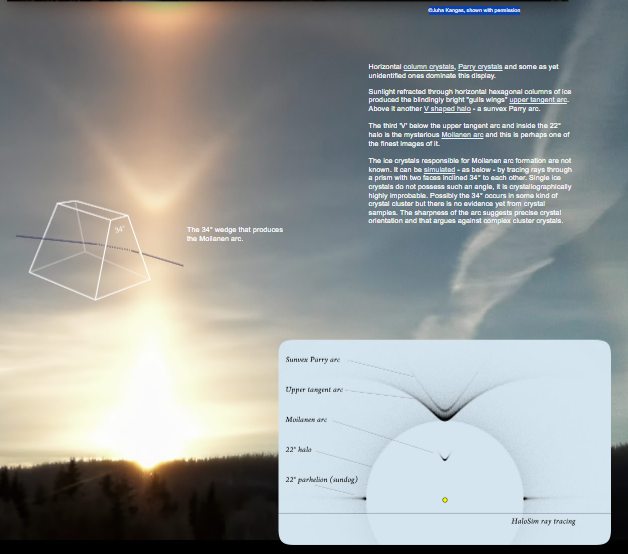OPOD - Swedish Ice Halos, Moilanen Arc
OPOD - Swedish Ice Halos, Moilanen Arc
Ice halos are a captivating atmospheric phenomenon that can transform the sky into a breathtaking spectacle. On November 25, '12, Juha Kangas captured an extraordinary display of ice halos in Åre, Sweden. This stunning image showcases the beauty and complexity of these optical phenomena.
In this particular display, a combination of horizontal column crystals, Parry crystals, and some unidentified crystals dominate the scene. The refraction of sunlight through horizontal hexagonal columns of ice gives rise to the dazzling "gulls wings" upper tangent arc. Positioned above it is another V-shaped halo known as a sunvex Parry arc.
However, the most intriguing feature of this image is the presence of the enigmatic Moilanen arc. Located below the upper tangent arc and within the 22° halo, the Moilanen arc remains shrouded in mystery. The ice crystals responsible for its formation have not been definitively identified, adding to its mystique.
The formation of the Moilanen arc can be simulated by tracing rays through a prism with two faces inclined at a specific angle of 34° to each other. Interestingly, individual ice crystals do not naturally possess such an angle, making it highly improbable for them to be the sole cause of this phenomenon. It is possible that the 34° angle occurs within some form of crystal cluster, although no concrete evidence has been found from crystal samples to support this hypothesis. The sharpness and precision of the Moilanen arc suggest a distinct crystal orientation, which contradicts the notion of complex cluster crystals being responsible.
While the exact mechanism behind the Moilanen arc remains elusive, its presence in this image showcases its rarity and significance. By capturing this ethereal phenomenon in such detail, Juha Kangas has provided scientists and enthusiasts with valuable insights into the world of atmospheric optics.
Ice halos, including the Moilanen arc, continue to captivate researchers and photographers alike. These optical phenomena are formed when light interacts with ice crystals suspended in the atmosphere, resulting in a stunning array of halos, arcs, and other celestial shapes. The intricate nature of ice halo formation is still being studied, and each new observation contributes to our understanding of these captivating phenomena.
In conclusion, the Swedish ice halos captured by Juha Kangas in Åre, Sweden, provide a mesmerizing glimpse into the world of atmospheric optics. The presence of the elusive Moilanen arc adds an air of intrigue and excitement to this already breathtaking display. While the exact nature of the ice crystals responsible for the Moilanen arc remains unknown, the image serves as a testament to the beauty and complexity of ice halo formations. As we continue to explore and unravel the mysteries of atmospheric optics, images like these remind us of the wonders that await us in the skies above.

Swedish Ice Halos
Juha Kangas imaged this unusual display on November 25, '12 at Åre, Sweden.
©Juha Kangas, shown with permission

Horizontal column crystals, Parry crystals and some as yet unidentified ones dominate this display.
Sunlight refracted through horizontal hexagonal columns of ice produced the blindingly bright "gulls wings" upper tangent arc. Above it another V shaped halo - a sunvex Parry arc.
The third 'V' below the upper tangent arc and inside the 22° halo is the mysterious Moilanen arc and this is perhaps one of the finest images of it.
The ice crystals responsible for Moilanen arc formation are not known. It can be simulated - as below - by tracing rays through a prism with two faces inclined 34° to each other. Single ice crystals do not possess such an angle, it is crystallographically highly improbable. Possibly the 34° occurs in some kind of crystal cluster but there is no evidence yet from crystal samples. The sharpness of the arc suggests precise crystal orientation and that argues against complex cluster crystals.
The 34° wedge that produces the Moilanen arc.
Note: this article has been automatically converted from the old site and may not appear as intended. You can find the original article here.
Reference Atmospheric Optics
If you use any of the definitions, information, or data presented on Atmospheric Optics, please copy the link or reference below to properly credit us as the reference source. Thank you!
-
<a href="https://atoptics.co.uk/blog/opod-swedish-ice-halos-moilanen-arc/">OPOD - Swedish Ice Halos, Moilanen Arc</a>
-
"OPOD - Swedish Ice Halos, Moilanen Arc". Atmospheric Optics. Accessed on November 15, 2024. https://atoptics.co.uk/blog/opod-swedish-ice-halos-moilanen-arc/.
-
"OPOD - Swedish Ice Halos, Moilanen Arc". Atmospheric Optics, https://atoptics.co.uk/blog/opod-swedish-ice-halos-moilanen-arc/. Accessed 15 November, 2024
-
OPOD - Swedish Ice Halos, Moilanen Arc. Atmospheric Optics. Retrieved from https://atoptics.co.uk/blog/opod-swedish-ice-halos-moilanen-arc/.